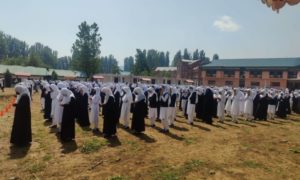In polarised times like these, when the world is increasingly electing strongmen to power, institutions swiftly change their stand on the legitimate and recognised issues. A fallacious editorial by the New York Times on May 18, was one such brazen attempt to mess with the nature of the world’s oldest unresolved conflict—Kashmir.
In the backdrop of the ‘Ramzan Ceasefire’ announced by New Delhi in the Valley, NYT’s opinion piece—A Long Shot in Kashmir—by its Editorial Board has resorted to spin and slant. In just one ‘long shot’, by calling the rebels ‘Islamists’, the editorial shamelessly ignores the yesteryear’s call of the Resistance leaders for a political solution of the dispute, which is in complete sync with the aspirations of the people of Kashmir.
A little fact-finding could’ve enlightened the board that the pioneers of the insurgency in Kashmir had a political agenda than an ‘Islamic’ one. But despite parachuting its reputed journalists to cover the Kashmir insurgency during nineties, the NYT has come to believe in its own propaganda on Kashmir now.
And even if the cry of ‘resistance’ leaders is ignored, which is what mostly happens, how could the opinionists at NYT ignore what the so-called ‘mainstream’ parties are saying?
Everyone, including the ruling Peoples Democratic Party, which is in alliance with the right-wing Hindu Bhartiya Janta Party, has been, since day one, calling for a political resolution of the Kashmir dispute.
As far as the armed rebels are considered, except the newly formed Ansar-ul-Ghazwat-e-Hind, all others, including the Pakistan-backed Lashkar-e-Toiba have said that Kashmir’s struggle for freedom is indigenous and political in nature.
In the second Para of the editorial, Kashmir issue has been called a ‘territorial dispute’, which absolutely undermines the aspirations of the people of the territory in question.
A plebiscite was promised by the first prime minister of India, which never happened. People have been demanding their Right to Self Determination since the conflict started. It’s not a territorial dispute between two warring nations, but a question of allowing the indigenous population to decide their future.
The editorial says that the Ramzan ceasefire was sought by the Chief Minister Mehbooba Mufti so that a conducive environment for peace could be created. However, the ceasefire has not been so effective. Such measures, countless in number, have been taken by successive governments yielding no results.
A history of broken promises prompted the rebel groups to reject the ceasefire. The resistance leaders also called it a cosmetic measure. Chairman of the Hurriyat (M) Mirwaiz Umar Farooq has said, What after Ramzan, will the Government of India start killing people again?
His question remains unanswered.
Recently, the National President of the BJP, Amit Shah said that the ceasefire was not against the militants. In a way, he accepted that the Indian Army is at war with the entire civilian population of the state. This came months after the Indian Army Chief Bipin Rawat wished to see guns instead of stones in the hands of dissenting Kashmiris, in what he termed a “dirty war”.
Another huge faux pas in the piece is the bizarre juxtaposing of the Mumbai attacks with the Kashmir issue. Due to the unfortunate event, peace talks derailed between the two countries, but the editorial has portrayed that ‘Islamist terrorists’ blamed for the tragedy are the same who are at work in Kashmir.
It has been mentioned many a times that Pakistan supports the ‘Islamist terrorists’ in the valley. The statement held true to an extend when rebels rose against the Indian rule in the valley in the 90s. The support now, is more moral, than practical. If it would’ve been logistical, then young boys would not have been snatching guns of the police in desperation.
The snatching has reached to a point that the police had to pen down an order which now bans sentries (beat cops) from using smartphones while on duty.
And one doesn’t need Washington’s peace-brokering role in the conflict, as the editorial advocates, to believe how New Delhi’s martial handling of the UN-recognised issue is fanning trouble and tempers in the region.
Also by putting the entire blame on Islamabad for the holdup dialogue on Kashmir, a naivety in NYT’s Editorial Board seems at play. A little-finding could’ve helped the board to understand that much of the reticence on talks stems from New Delhi. We reckon, it’s high time for NYT to check their facts on Kashmir besides fire their Long Shot fact-finders!








